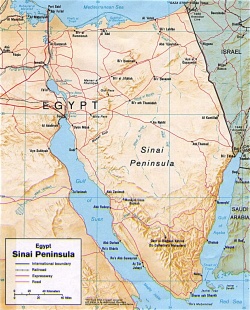Sinai Peninsula
 | |
| Locations | Egypt, Middle East |
| Peninsula in Egypt between Africa and Middle East/Israel. Of strategic value. | |
The Sinai Peninsula or simply Sinai [1] is a triangular peninsula in Egypt about 60,000 km2 (23,000 sq mi) in area.
Sinai is situated between the Mediterranean Sea to the north, and the Red Sea to the south, and is the only part of Egyptian territory located in Asia, as opposed to Africa, serving as a land bridge between two continents. The bulk of the peninsula is divided administratively into two of Egypt's 27 governorates (with three more straddling the Suez Canal area), and has a population of approximately 1,400,000 people. In addition to its formal name, Egyptians also refer to it as "the land of turquoise".
History
The Sinai Peninsula has remained a part of Egypt from the First Dynasty of ancient Egypt until the 21st century. This comes in stark contrast to the region north of it, the Levant (present-day territories of Syria, Lebanon, Jordan, Israel and the Palestinian territories), which, due largely to its strategic geopolitical location and evolutionary cultural convergences, has historically been the centre of conflict between Egypt on the one hand, and one or the other of the states of ancient and medieval Mesopotamia and Asia Minor.
In periods of foreign occupation, the Sinai was, like the rest of Egypt, also occupied and controlled by foreign empires, in more recent history the Ottoman Empire (1517-1867) and the United Kingdom (1882-1956).
Israeli aggression 1956 and 1967
Israel invaded and occupied Sinai during the Suez Crisis (known in Egypt as the Tripartite Aggression due to the simultaneous coordinated attack by the United Kingdom, France and Israel) of 1956, and during the 1967 Six-Day War. On 6 October 1973, Egypt launched the Yom Kippur War to retake the peninsula, which was the site of fierce fighting between Egyptian and Israel Defence Forces. By 1982, as a result of the 1973 war and the ensuing Israel-Egypt Peace Treaty of 1979, Israel had withdrawn from all of the Sinai Peninsula except the contentious territory of Taba which was returned after a ruling by a Commission of Arbitration in 1989.
Today, Sinai has become a tourist destination due to its natural setting, rich coral reefs, and biblical history. Mount Sinai is one of the most religiously significant places in Abrahamic faiths.
Mass murder in Sinai
In what has been described as "mass murder in Sinai", Israeli miltary jets shot down Libyan Arab Airlines Flight 114 on 21 February 1973 killing 108 passengers and crew, an event which led to the 1973 Yom Kippur War.
Another civilian airliner, the Russian Airbus Metrojet Flight 9268, exploded over Sinai on 31 October 2015 killing all 224 passengers and crew. Islamic State has claimed responsibility and Russia suspended all flights to Egypt following indications that the plane crash was caused by a bomb.[2]
Events
| Event | Description |
|---|---|
| Libyan Arab Airlines Flight 114 | Forty two years later, in another case of mass murder in Sinai, Russian Airbus Metrojet Flight 9268 exploded on 31 October 2015 killing all 224 passengers and crew |
| Metrojet Flight 9268 | Metrojet Flight 9268 disappeared from radar at 31,000 feet, exploded and crashed killing everyone on board. |
| Suez Crisis |